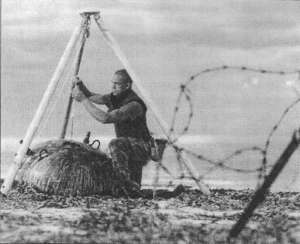- Author
- Maxwell, Eugene
- Subjects
- RAN operations, Post WWII
- Tags
-
- RAN Ships
- None noted.
- Publication
- December 2007 edition of the Naval Historical Review (all rights reserved)
Watching the ships enter the cleared port on 12 March marked the end of our stay at Ash Shu’Aybah, and provided us with the gratification of knowing we had done the job properly. A number of the mines we rendered safe are now on display in military museums in Australia. With this success under our belts, we turned to our next task, the clearance of the deserted Kuwait naval base at Ras Al Qulai’ah. This was to be a solo effort by CDT3.

Ras Al Qulai’ah
On the morning of 14 March, we stood in Ras Al Qulai’ah, stunned by the devastation. A combination of allied air attacks and Iraqi sabotage had reduced this modern naval base to a jumbled mess of concrete and steel. Plastic explosives, detonators and various small arms littered the wharves. Splitting into clearance teams, we commenced searching the wharves and buildings for booby traps and demolition remotely jarring the bomblets, they were removed to a safe disposal area to await destruction.
To escape the bombing, the occupying Iraqi forces here had lived in the service tunnels under the thick concrete wharves. We carefully picked our way through the subterranean villages by torchlight, stepping over cooking utensils and skirting mattresses perched on brick stilts above the two inches of slimy water that was the carpet of these impromptu barracks. After three long days continuous diving, we completed the clearance of the harbour areas of the port.
The good visibility (up to three metres at times), and the fact that no mines or corpses were encountered, made this port more pleasant to dive – but the fact that numerous cluster bomblets littered the seabed made it damned treacherous. Some shattered, but most intact, the bomblets lay threateningly on the sand. The deadliest stood vertical, nose fuses buried in charges. Treading lightly, and with senses on full alert, we cleared what had been an Iraqi mine-laying factory. Buoyant mine components and containers filled the warehouse, but alas, the mines themselves were going to be harder to find – all the boxes were empty! Moving through the buildings and onto the wharves, we began to encounter unsuccessful demolition charges and unexploded cluster bomblets, which received particular care. These could explode at the slightest touch. After the sand, where the impact of entering the water had slowed them down sufficiently to strike the seabed without detonating. Hopefully you would see them before stumbling into one, and you prayed that your buddy would too; the slightest movement or jarring could result in a detonation that would not only incapacitate the offender, but any other diver in the vicinity with the resultant shock waves. We normally operated 20 to 40 metres apart. After a two hour search in such an environment, everyone was glad to be hauled back into the Zodiac for a well-earned wash down and hot brew.
Once again, our mine disposal parties continued to clear the nearby beaches, with the daily hazard of sporadic gunfire in their vicinity. On one memorable occasion, a team member began to receive incoming rounds as he was attempting to probe his way to a beached mine. Feeling a tad indignant, our gallant member grabbed his M203 (an M16 with grenade launcher attached), and stormed off to the nearby abandoned houses to investigate. There he found a group of young Kuwaiti men teaching themselves to shoot an AK47. As our man explained the advantages of clearing a mine without having bullets whistling around your backside, the group were last seen scurrying at high speed into a car, leaving behind a fast-diminishing cloud of dust and Aussie rhetoric.
Once again the environment affected our operations and on occasions it became so dark during the day that torches had to be used. Six days after entering the naval base, we declared it and the surrounding areas safe for use. We had swum over 41,100 square metres of harbour in 44 hours of diving over three days. Groaning at the thought of packing our gear once again, we struck camp and headed to rejoin the other diving units for the clearance of the main port of Kuwait City.
Shuwaikh Port
On 23 March our convoy of four semi-trailers and assorted passenger vehicles emerged from the stark countryside into the relatively colourful suburbs of the city. Colourful as they were, they could not bring to life the city of Kuwait. Seemingly devoid of human life, and with tanks, trucks and cars strewn haphazardly on both sides of the highway, Kuwait was empty. Passing mostly military traffic, we were stopped at various checkpoints by Kuwaiti militia, with nervous grins on both sides until our recognition as allies had been established. Soon we got our first look at the city that had once held the world’s undivided attention. Though it was largely deserted and a number of buildings had been damaged, the city was relatively untouched. The obligatory bunkers and fortifications stood tall.




